
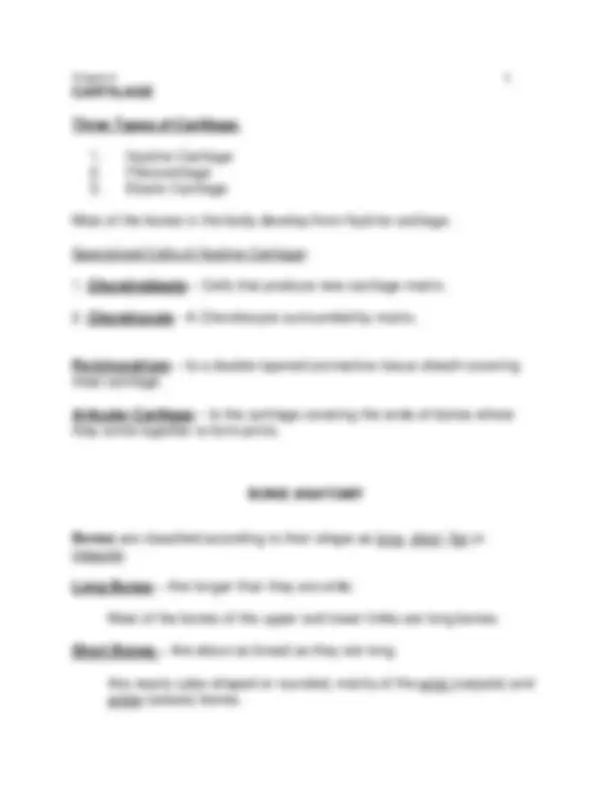
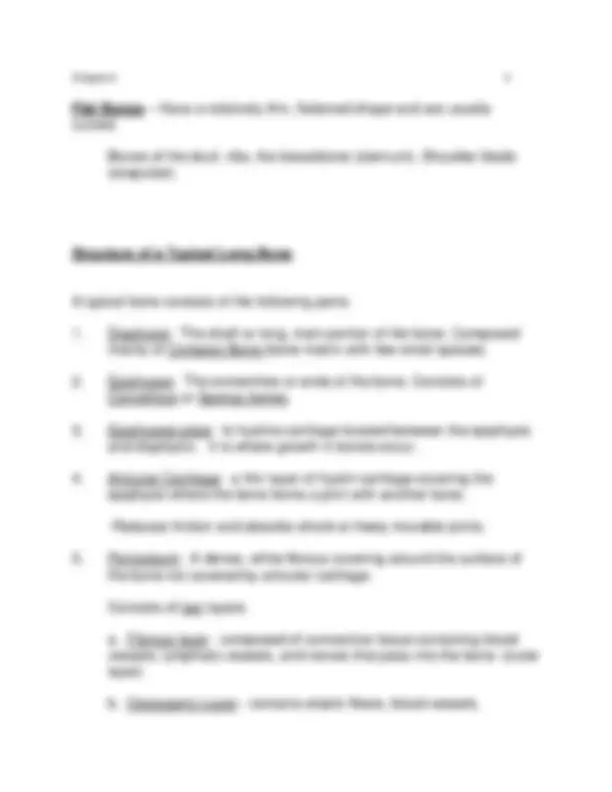
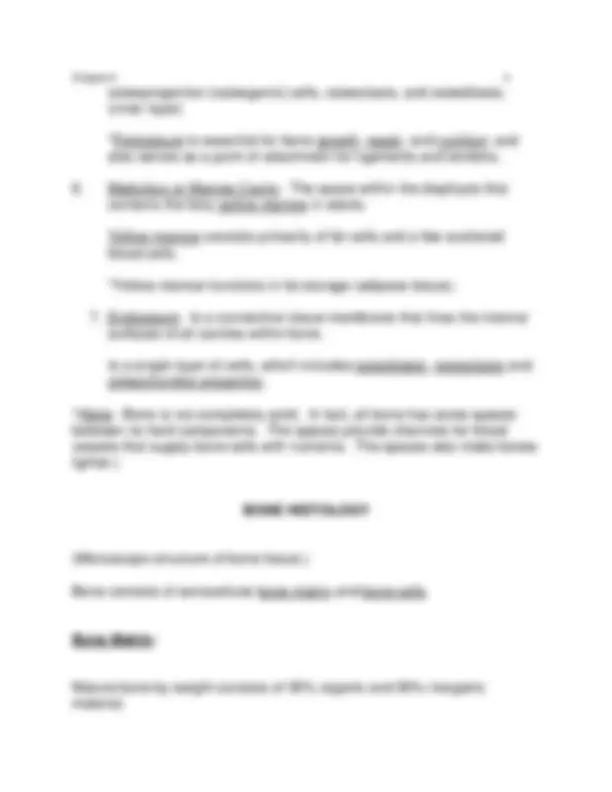
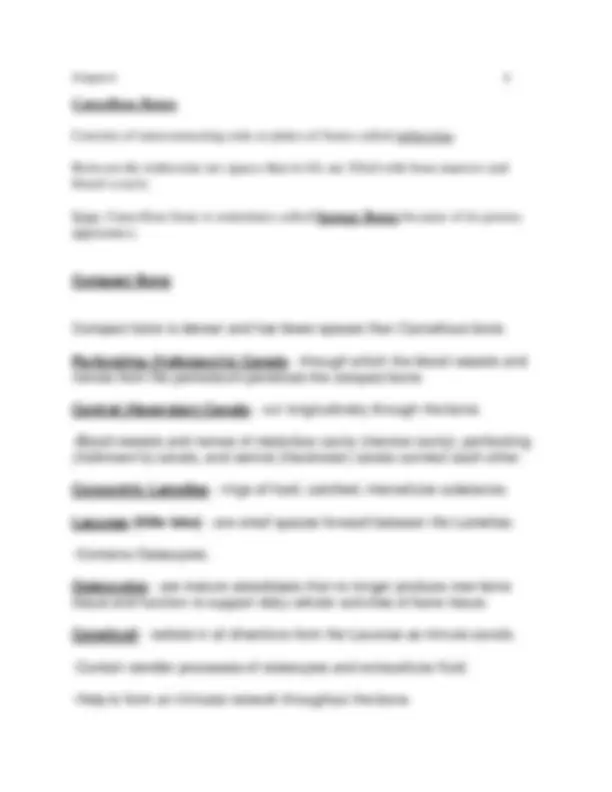
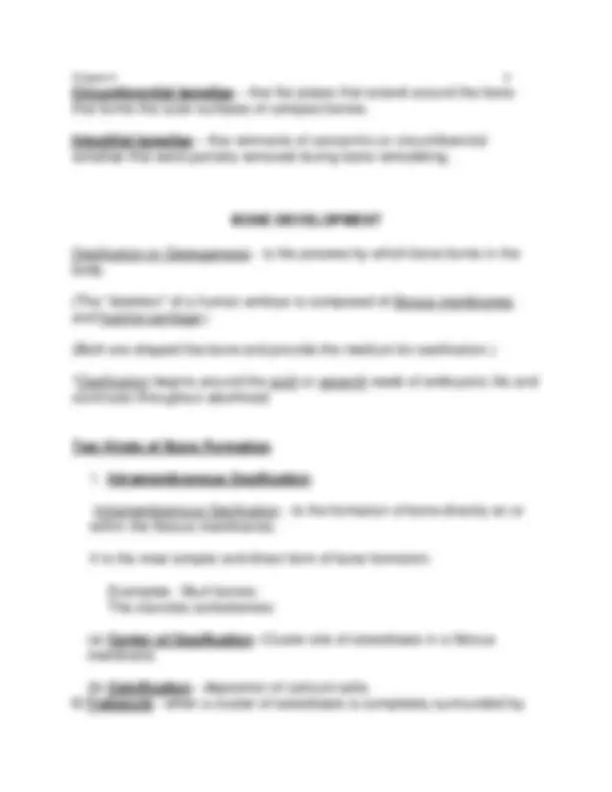
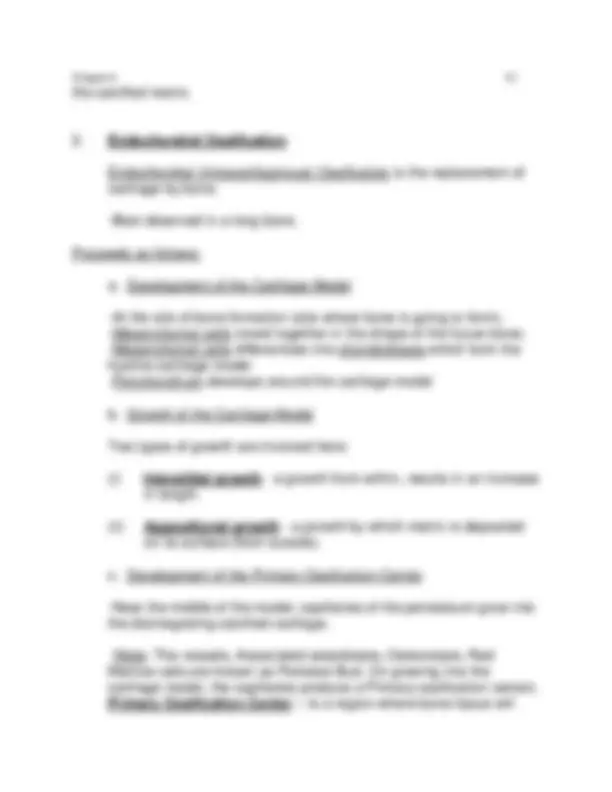
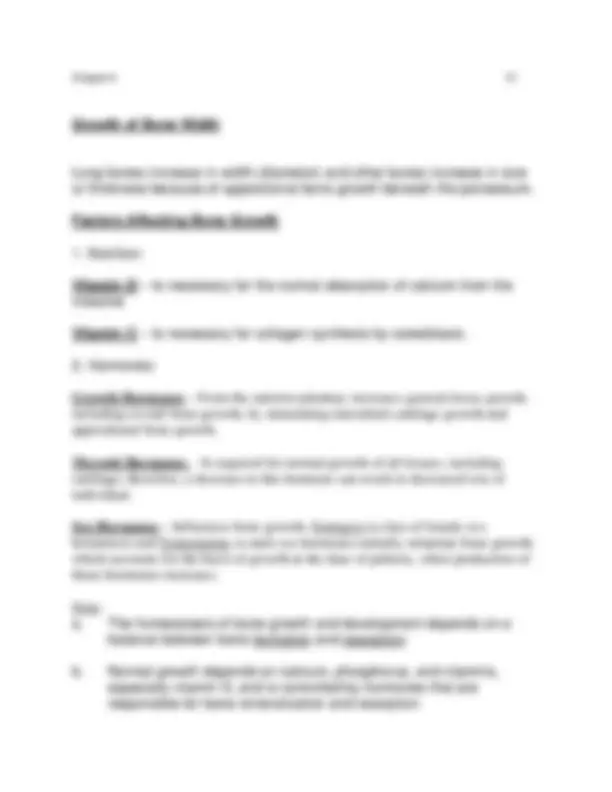
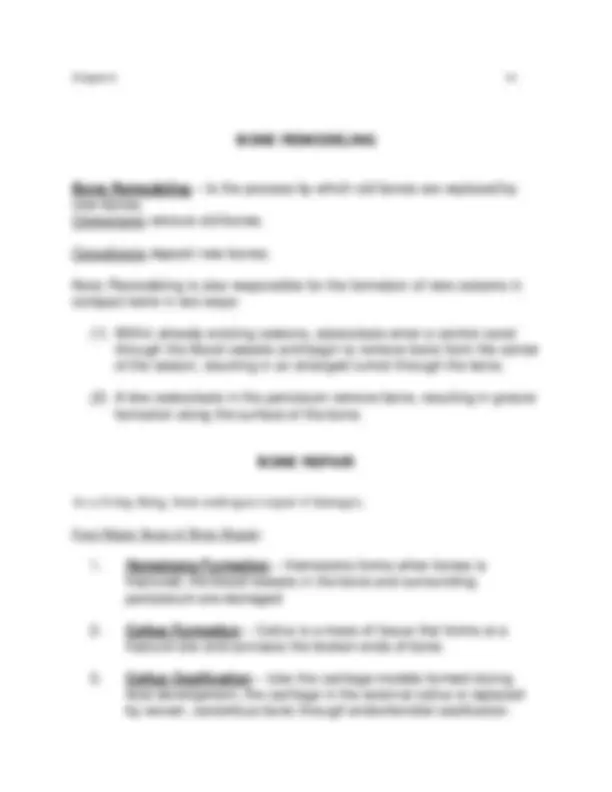
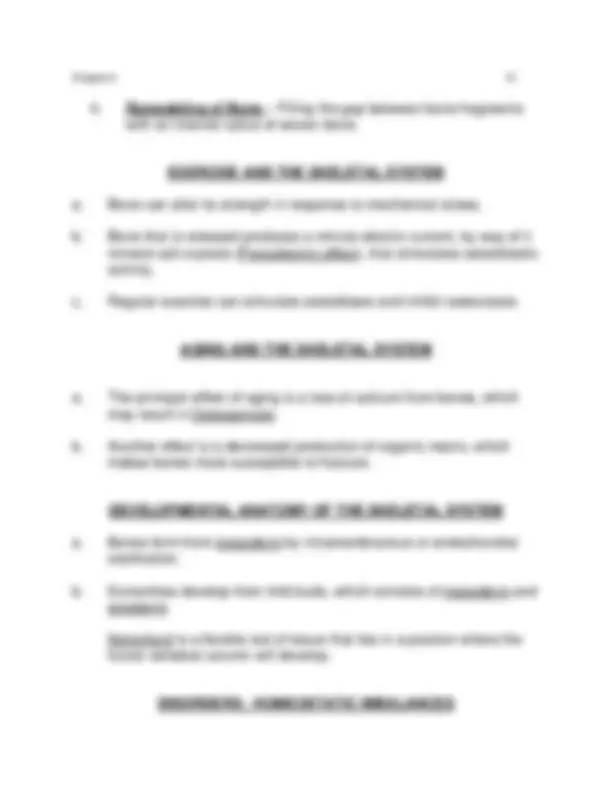
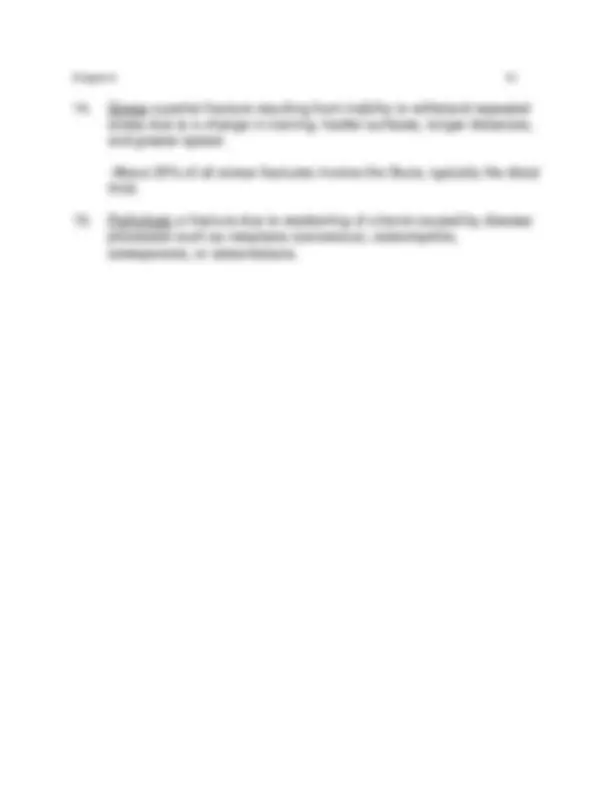


Study with the several resources on Docsity

Earn points by helping other students or get them with a premium plan


Prepare for your exams
Study with the several resources on Docsity

Earn points to download
Earn points by helping other students or get them with a premium plan
Community
Ask the community for help and clear up your study doubts
Discover the best universities in your country according to Docsity users
Free resources
Download our free guides on studying techniques, anxiety management strategies, and thesis advice from Docsity tutors
Chapter 6 Marieb Human Anatomy and Physiology Material Type: Notes; Professor: Gunn; Class: Anatomy and Physiology; Subject: Biology; University: University of Texas - Pan American;
Typology: Study notes
1 / 18

This page cannot be seen from the preview
Don't miss anything!











Bone (Osseous) Tissue forms most of the skeleton:
Skeletal System - the framework of bones and cartilage that protects our organs and allows us to move.
Osteology - is the study of bone structure and treatment of bone disorders.
(Without the skeletal system we would be unable to perform movements such as walking or grasping. The slightest jar to the head or chest could damage the brain or heart. It would even be impossible to chew.)
Yellow Marrow - consists primarily of adipose cells and a few scattered blood cells.
Flat Bones – Have a relatively thin, flattened shape and are usually curved.
Bones of the skull, ribs, the breastbone (sternum). Shoulder blade (scapulae).
Structure of a Typical Long Bone
A typical bone consists of the following parts:
-Reduces friction and absorbs shock at freely movable joints.
Consists of two layers:
a. Fibrous layer - composed of connective tissue containing blood vessels, lymphatic vessels, and nerves that pass into the bone. (outer layer)
b. Osteogenic Layer - contains elastic fibers, blood vessels,
osteoprogenitor (osteogenic) cells, osteoclasts, and osteoblasts. (inner layer)
*Periosteum is essential for bone growth, repair, and nutrition; and also serves as a point of attachment for ligaments and tendons.
Yellow marrow consists primarily of fat cells and a few scattered blood cells.
*Yellow marrow functions in fat storage (adipose tissue).
Is a single layer of cells, which includes osteoblasts, osteoclasts and osteochondral progenitor.
*(Note: Bone is not completely solid. In fact, all bone has some spaces between its hard components. The spaces provide channels for blood vessels that supply bone cells with nutrients. The spaces also make bones lighter.)
(Microscopic structure of bone tissue.)
Bone consists of extracellular bone matrix and bone cells.
Bone Matrix:
Mature bone by weight consists of 35% organic and 65% inorganic material.
Origin of Bone Cells:
Connective tissue develops embroyologically from mesenchymal cells.
Stem Cells – Have the ability to replicate and give rise to more specialized cell types.
Osteochondrial progenitor cells – Are stem cells that have the ability to become osteoblasts and chondrioblasts.
Note: Osteoblasts are derived from osteochondral progenitor cells, and osteocytes are derived from osteblasts.
Woven and Lamellar Bone
According to the organization of collagen fibers within the bone matrix, bone tissue is classified as (a) Woven bone or (b) Lamellar bone.
(a) Woven bone – Collagen fibers are randomly oriented in many direction.
(b) Lamellar bone – Is mature bone that is organized into thin sheets or layers called lamellae.
Cancellous and Compact Bone
Bone woven or lamellar are classified according to the amount of bone matrix relative to the amount of space present within the bone.
Cancellous bone has less matrix and more space while Compact bone has more matrix and less space.
Cancellous Bones
Consists of interconnecting rods or plates of bones called trabeculae.
Between the trabeculae are spaces that in life are filled with bone marrow and blood vessels.
Note: Cancellous bone is sometimes called Spongy Bones because of its porous appearance.
Compact Bone
Compact bone is denser and has fewer spaces than Cancellous bone.
Perforating (Volkmann's) Canals - through which the blood vessels and nerves from the periosteum penetrate the compact bone.
Central (Haversian) Canals - run longitudinally through the bone.
-Blood vessels and nerves of medullary cavity (marrow cavity), perforating (Volkmann's) canals, and central (Haversian) canals connect each other.
Concentric Lamellae - rings of hard, calcified, intercellular substance.
Lacunae (little lake) - are small spaces forward between the Lamellae.
-Contains Osteocytes.
Osteocytes - are mature osteoblasts that no longer produce new bone tissue and function to support daily cellular activities of bone tissue.
Canaliculi - radiate in all directions from the Lacunae as minute canals.
-Contain slender processes of osteocytes and extracellular fluid.
-Help to form an intricate network throughout the bone.
the calcified matrix.
Endochondral (Intracartilaginous) Ossification is the replacement of cartilage by bone.
-Best observed in a long bone.
Proceeds as follows:
a. Development of the Cartilage Model
-At the site of bone formation (site where bone is going to form),
b. Growth of the Cartilage Model
Two types of growth are involved here:
(i) Interstitial growth - a growth from within, results in an increase in length.
(ii) Appositional growth - a growth by which matrix is deposited on its surface (from outside).
c. Development of the Primary Ossification Center
-Near the middle of the model, capillaries of the periosteum grow into the disintegrating calcified cartilage.
(Note: The vessels, Associated osteoblasts, Osteoclasts, Red Marrow cells are known as Peristeal Bud. On growing into the cartilage model, the capillaries produce a Primary ossification center). Primary Ossification Center – Is a region where bone tissue will
replace most of the cartilage.
d. Development of the Diaphysis and Epiphysis
-Diaphysis (shaft), which was once a solid mass of hyaline cartilage; is replaced by compact bone; the central part of which contains a real marrow-filled medullary cavity.
Secondary Ossification Center develop usually around the time of birth, when blood vessels (epiphyseal arteries) enter the epiphyses.
*Chondroblast - a cartilage forming cell. *Chondroclast - a cartilage destroying cell. *Chondrocyte - a mature cartilage cell.
Bones increase in size only by Appositional Growth.
Unlike Cartilage, bone cannot grow by Interstitial Growth.
Growth of Bone Length
Long bones and bony projections increase in length because of growth at the Epiphyseal Plate.
(Note: Growth at the epiphyseal plate involves the formation of new cartilage by interstitial cartilage growth followed by appositional bone growth on the surface of the cartilage).
Four Zones of the Epiphyseal Plate
a. Zone of Resting Cartilage is near the epiphysis and consists of small chondrocytes that are scattered irregularly throughout the
Growth of Bone Width
Long bones increase in width (diameter) and other bones increase in size or thickness because of appositional bone growth beneath the periosteum.
Factors Affecting Bone Growth
Vitamin D – Is necessary for the normal absorption of calcium from the intestine
Vitamin C – Is necessary for collagen synthesis by osteoblasts.
Growth Hormones – From the anterior pituitary increases general tissue growth, including overall bone growth, by stimulating interstitial cartilage growth and appositional bone growth.
Thyroid Hormones - Is required for normal growth of all tissues, including cartilage; therefore, a decrease in this hormone can result in decreased size of individual.
Sex Hormones – Influences bone growth. Estrogen (a class of female sex hormones) and Testosterone (a male sex hormone) initially stimulate bone growth, which accounts for the burst of growth at the time of puberty, when production of those hormones increases.
Note: a. The homeostasis of bone growth and development depends on a balance between bone formation and resorption.
b. Normal growth depends on calcium, phosphorus, and vitamins, especially vitamin D, and is controlled by hormones that are responsible for bone mineralization and resorption.
Bone Remodeling – Is the process by which old bones are replaced by new bones. Osteoclasts remove old bones.
Osteoblasts deposit new bones.
Note: Remodeling is also responsible for the formation of new osteons in compact bone in two ways:
(1) Within already existing osteons, osteoclasts enter a central canal through the blood vessels and begin to remove bone from the center of the osteon, resulting in an enlarged tunnel through the bone.
(2) A few osteoclasts in the perioteum remove bone, resulting in groove formation along the surface of the bone.
As a living thing, bone undergoes repair if damages.
Four Major Steps of Bone Repair:
a. Osteoporosis is a decrease in the amount and strength of bone tissue owing to decrease in hormone output (decreased level of estrogens).
b. Vitamin Deficiencies
(i) Rickets - a deficiency of vitamin D in children.
-Characterized by an inability of the body to transport calcium and phosphorus from the gastrointestinal tract into the blood for utilization by bones.
(ii) Osteomalacia - Deficiency of Vitamin D in adults causes the bones to give up excessive amounts of calcium and phosphorus.
-This is called Demineralization.
c. Paget's Disease is the irregular thickening and softening of bones, related to a greatly accelerated remodeling process.
d. Osteomyelitis is a term for the infectious diseases of bones, marrow, and periosteum.
-It is frequently caused by "staph" bacteria.
e. Fracture (FX) any break in a bone.
Closed reduction - restoration of fracture to normal position by manipulation without surgery.
Open reduction - exposed by surgery before the break is rejoined.
Classification of Bone Fractures – A Clinical Focus